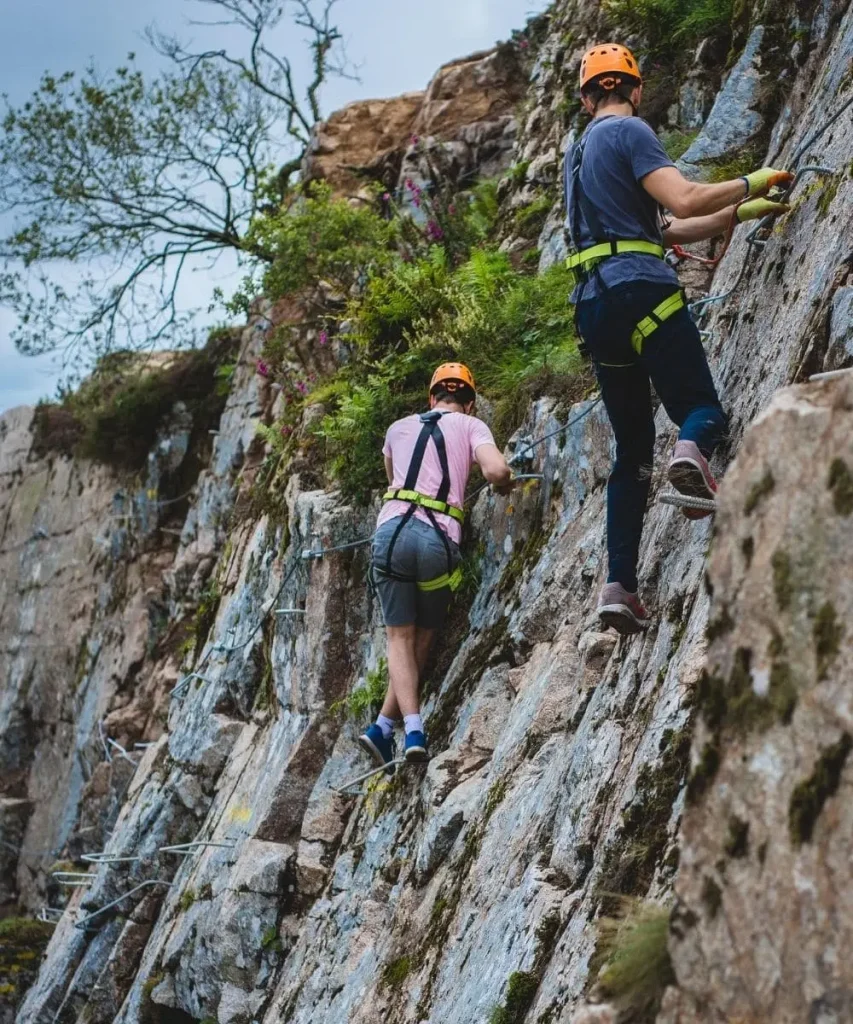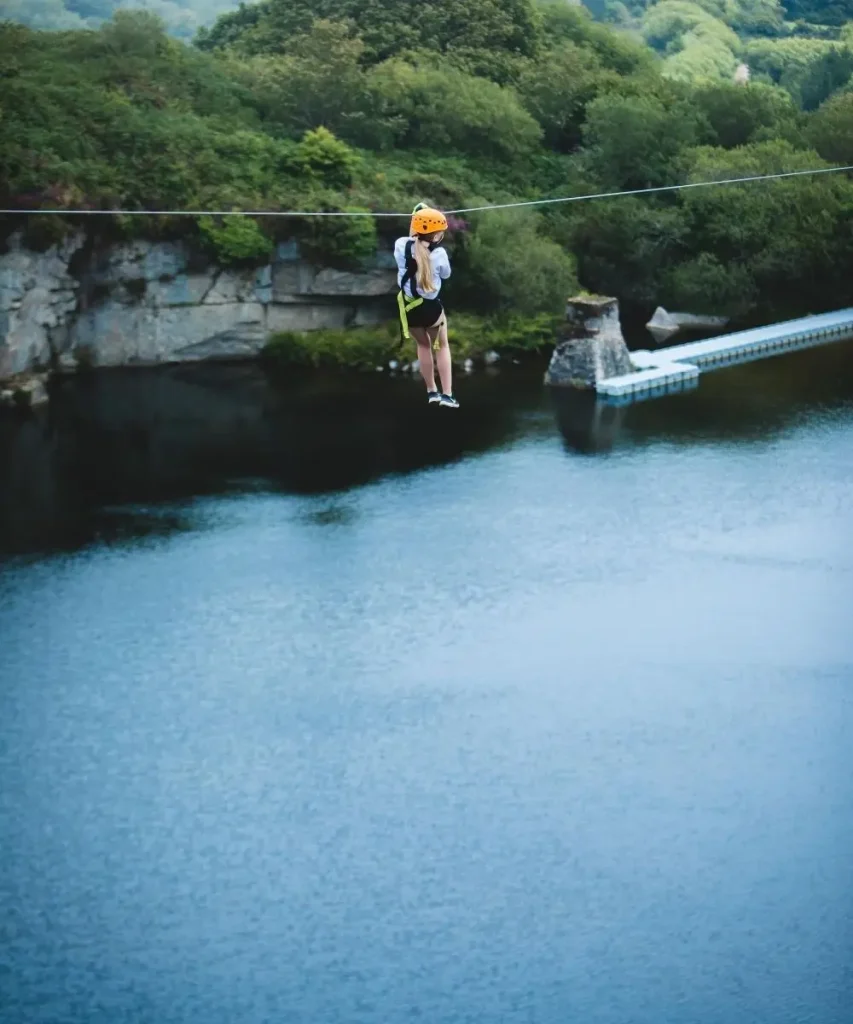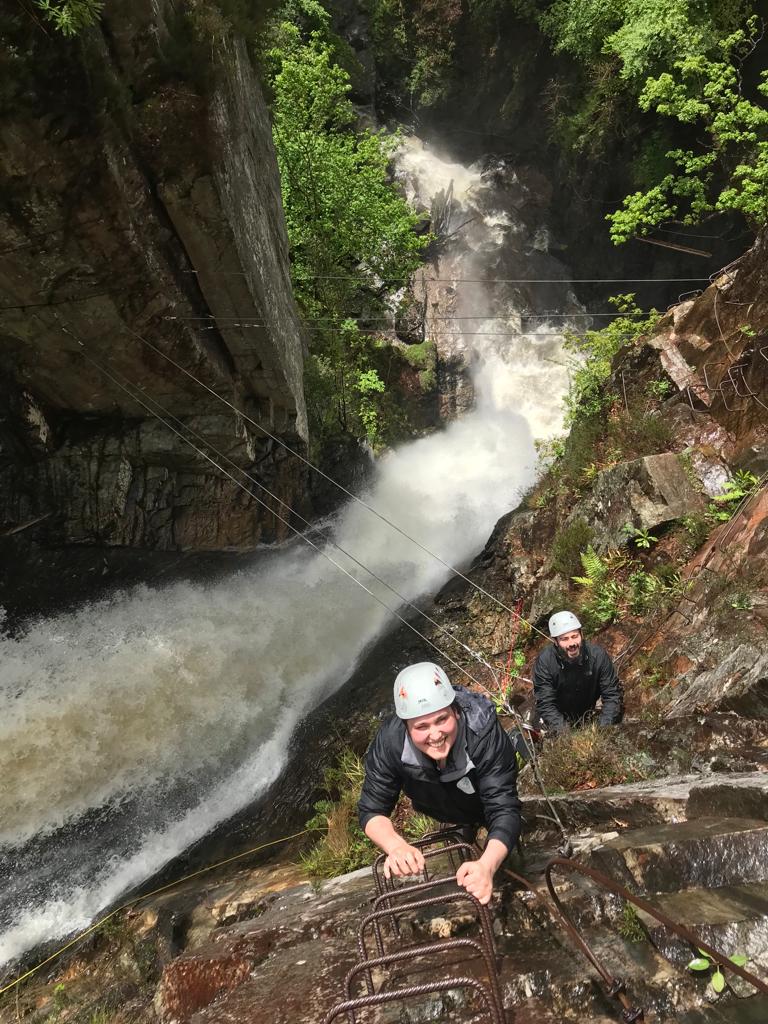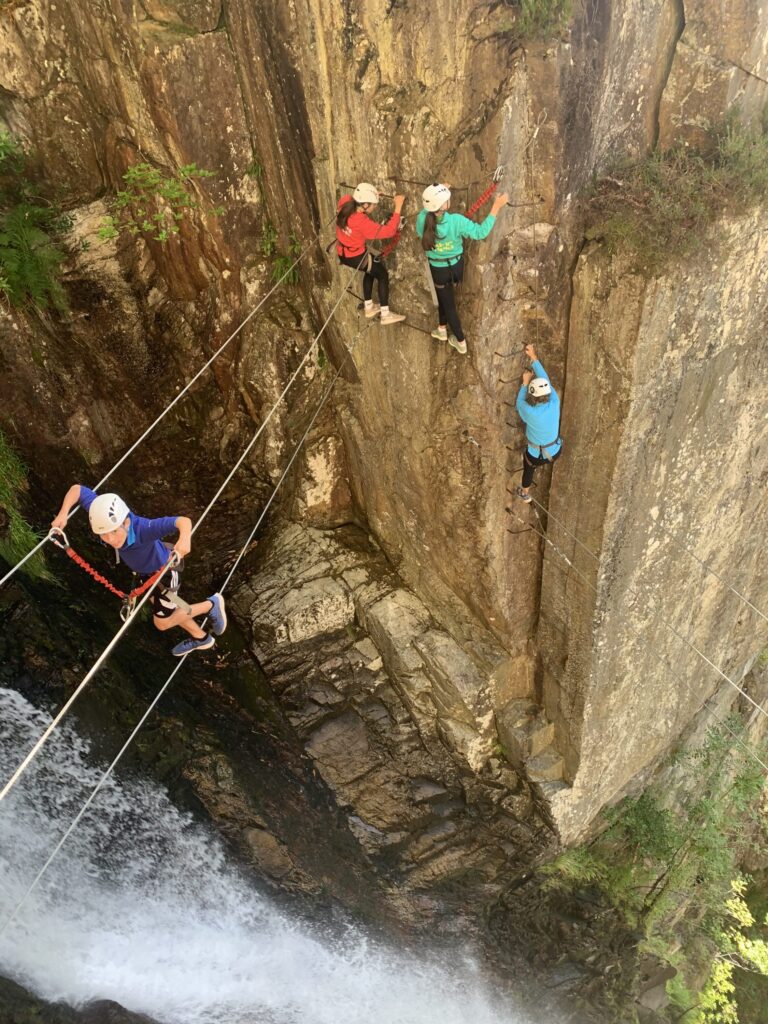Once the reserve of alpinists and mountaineering club members, via ferrata are becoming an increasingly popular way of exploring the vertical world and a major tourist attraction in destinations throughout Europe and even further afield. With a decent level of fitness, proper safety equipment and guidance, via ferrata can offer an exciting and unique experience with awe-inspiring views and exhilarating exposure.
Consider the below your ‘UK via ferrata 101’.
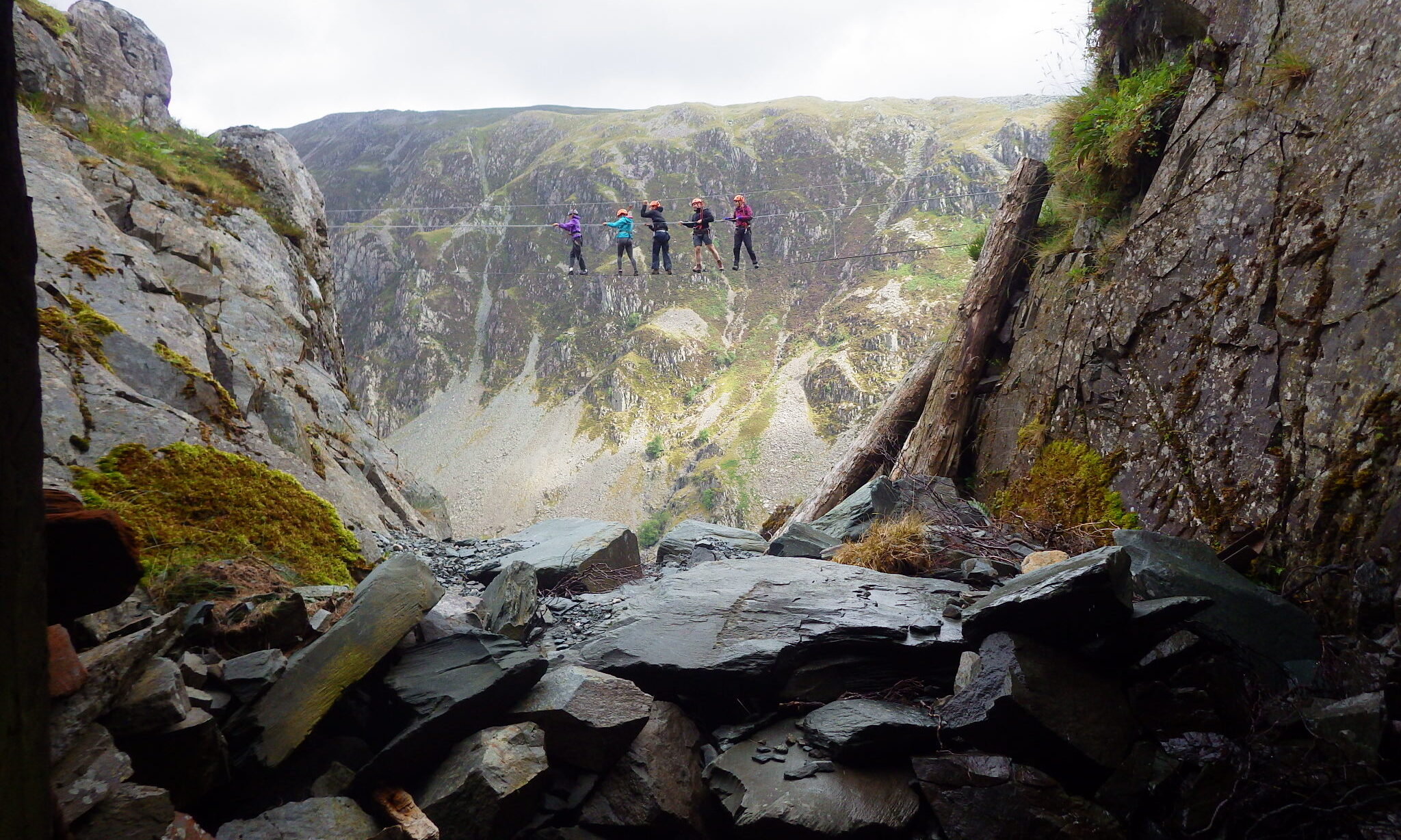
© Honister Via Ferrata
While the name probably conjures up images of scaling the rugged, turreted rock faces of the Dolomites or ascending into high alpine environments, we have five of our own via ferratas here in the UK. These include three in England, two in Wales and one in Scotland.
As it turns out, this alpine pastime has more than made its way onto UK soil in recent years, with offerings for adventurers with a head for heights to be found, with infinity bridges over gaping chasms, zip-lines in subterranean slate caverns and ladders scaling the side of a thundering waterfall, and some exciting interpretations of the original, historical format. While the UK may be lacking in altitude, it certainly has some thrills well worthy of note.
Many of the older European via ferratas are funded by local communities in order to attract tourism and they’re typically open to anyone to tackle without supervision. Via ferratas in the UK however are generally privately owned and maintained, which means you can’t do them without a guide. Most require booking in advance and using the centre’s own safety-tested equipment. Via ferrata excursions with a qualified guide can make for an excellent introduction to the activity, and many UK routes are suitable for beginners making it the perfect place to try your hand at via ferrata before venturing onto bigger terrain.
Read on, as below we give an overview of each site and what it has to offer.
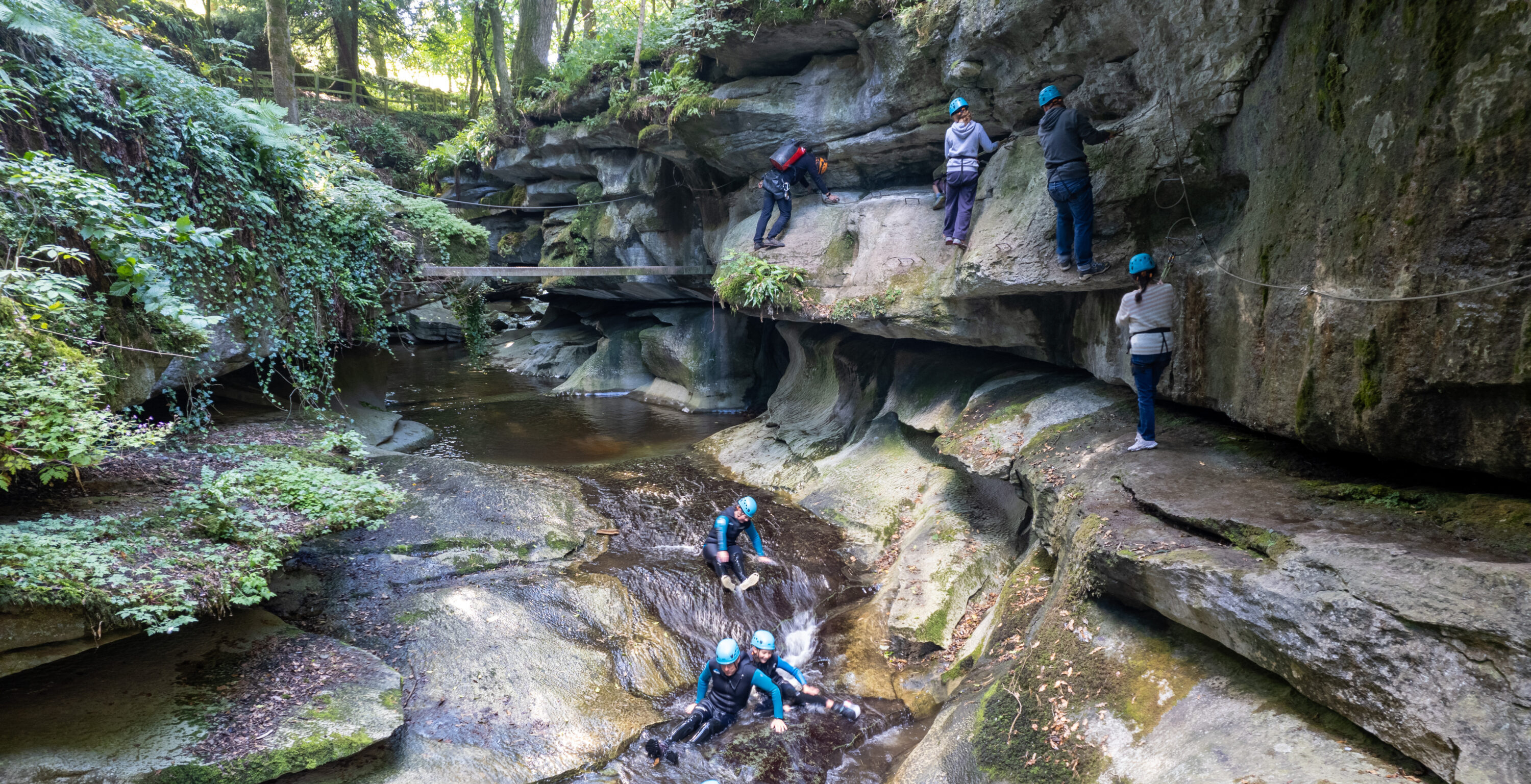
How Stean Gorge © George Lee
WHAT DOES VIA FERRATA MEAN?
Via ferrata is an Italian phrase that translates to Iron Path in English and is used to describe a series of metal cables, ladders and rungs or stemples which are fixed to a rock face in order to protect a climbing route. It is believed that these pathways have existed for centuries, used originally to connect villages in the Alps to high pastures, and later used by military personnel in World War I in locations such as the Italian Dolomites to transport equipment to strategic positions in the mountains. Latterly, these pathways were adopted by mountaineering clubs, who over the years added extra hardware in order to make them safer and more easily accessible. The term via ferrata is used across the world, except in German-speaking countries where the term klettersteig (climbing path) is more common.
IS VIA FERRATA SAFE?
Just like any activity in the mountains, via ferrata has inherent risks. Just how safe via ferrata is depends largely on using proper safety equipment, exercising caution and attention at all times and following the guidance of instructors. Of course, some risks simply cannot be eliminated, and rockfall and injuries sustained falling from the via ferrata itself are considered the two main risks associated with the activity.
Climbers scaling a via ferrata will use a harness and a specially-made safety setup involving a Y-shaped lanyard that is attached to the harness, with a carabiner on either end. The harness will typically be the same or very similar to a rock climbing harness and these should only ever be purchased from reputable brands or provided by the centre or instructor that is guiding you. The carabiners are used to secure the climber to the metal protection on the route as they move up. Passing fixed points (or transition posts) which are used to secure the metal rungs or cables to the rock, the climber will unclip one carabiner from the protective gear and into the next piece beyond the transition post before doing the same with the second carabiner. Used correctly, a via ferrata kit ensures that the climber is never not attached to the fixed metal gear, even when moving past a fixed or bolted point.
A proper via ferrata kit also includes a form of integrated braking device within the lanyard element. The reason for this is that it reduces the fall factor by absorbing the energy of the fall should it occur. Homemade or improvised via ferrata kits are NOT capable of doing this and will not protect a climber if they fall. Other essentials for a day on the iron path include a helmet, appropriate footwear such as approach shoes and gloves (sometimes specifically called ‘via ferrata gloves‘), either fingerless or not, and preferably with toughened palms to protect your hands from abrasions and the cold.
Outdoor centres and instructors offering via ferrata in the UK will help to equip you with all the necessary kit and guidance on how to use it properly.
Just how safe via ferrata is depends largely on using proper safety equipment, exercising caution and attention at all times and following the guidance of instructors.
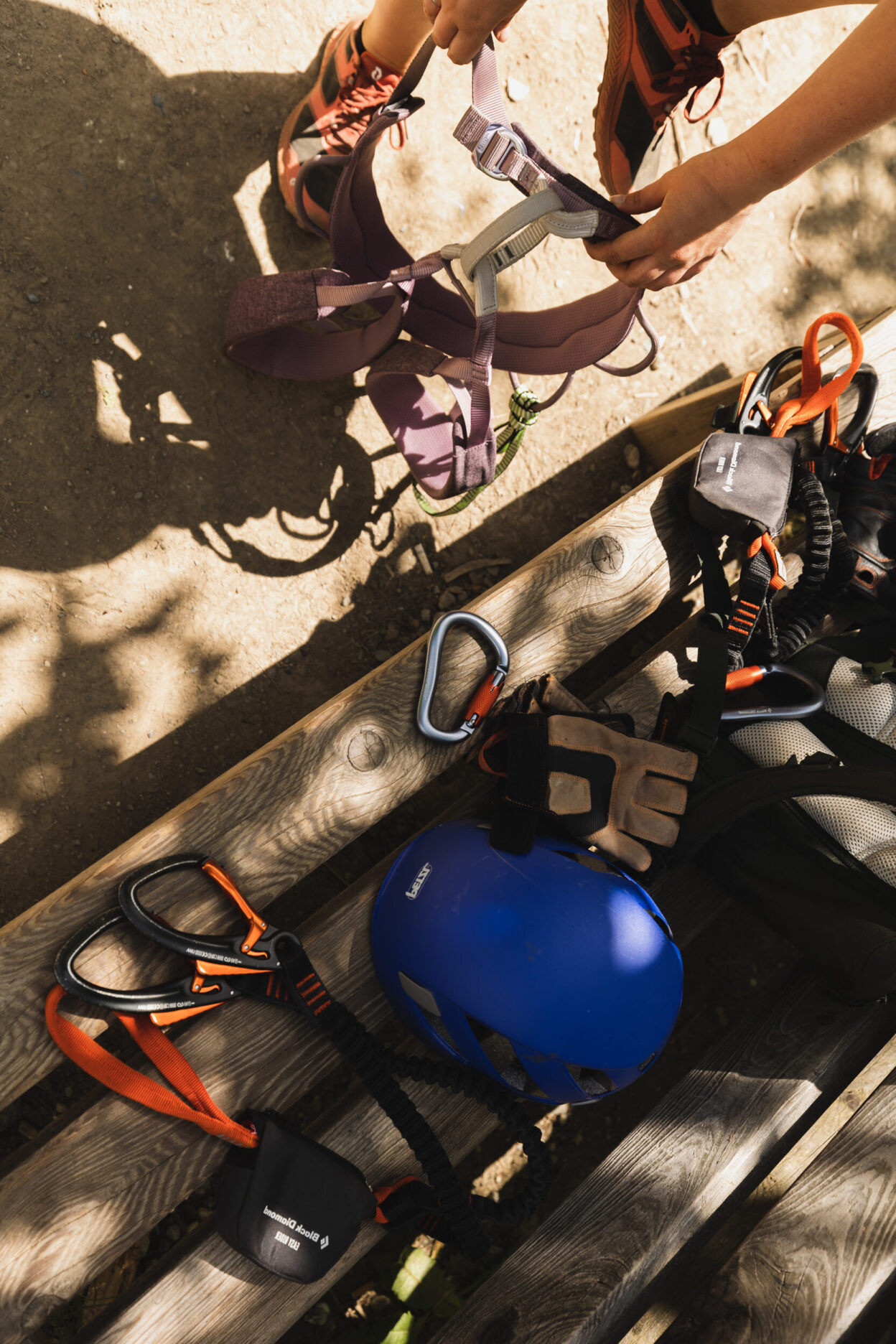
Purpose-made safety kit is required for Via Ferrata. © Johny Cook
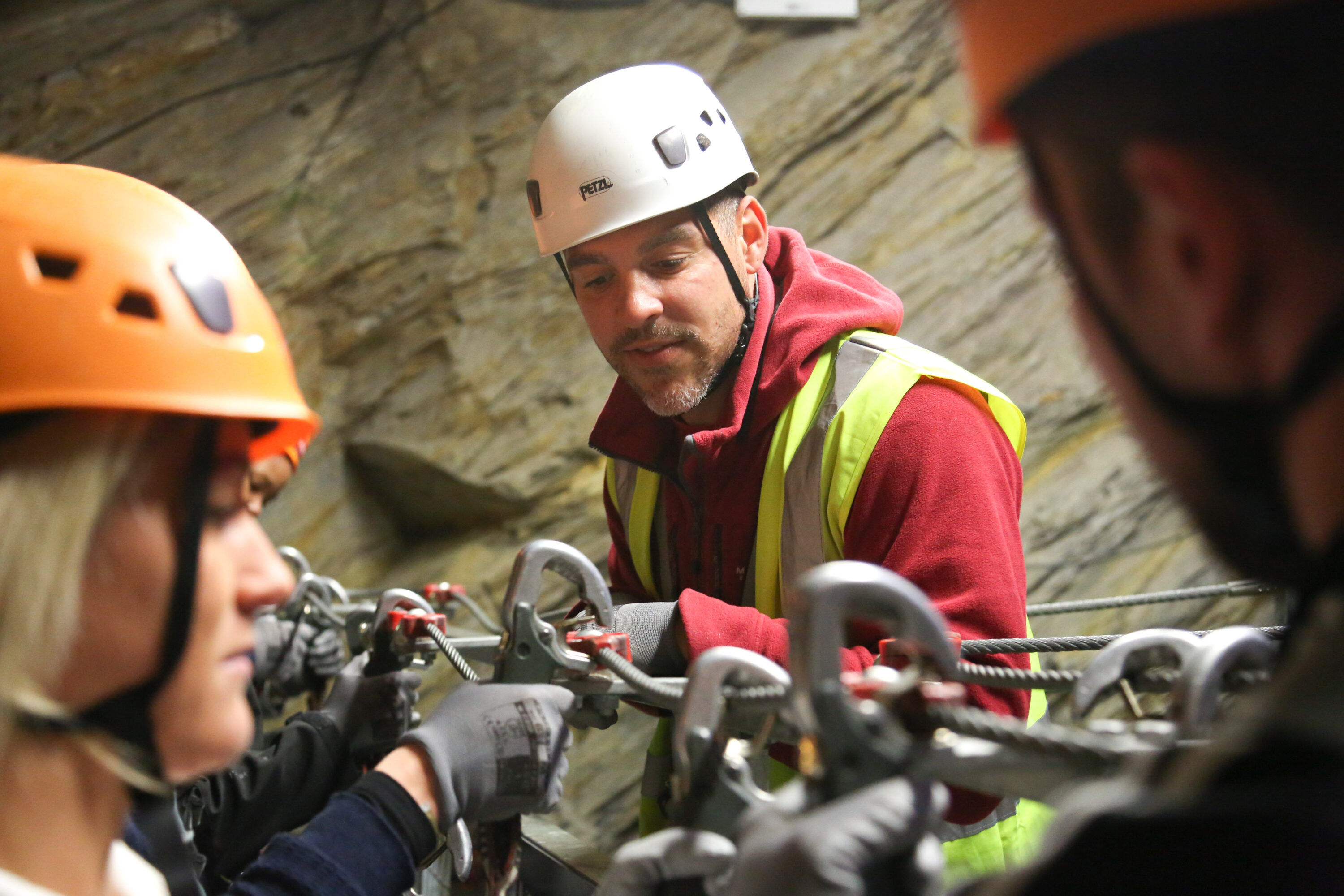
A qualified instructor can help to equip you with all the necessary kit and offer guidance on how to use it properly. © Zip World
How difficult is Via Ferrata?
In Europe, there are different classifications for via ferrata which indicate their difficulty. These vary from country to country and typically reflect the values used to grade climbing routes, taking into account elements such as technical difficulty, physical effort, exposure and environmental factors. The UIAA Mountaineering Commission adopted the Italian grading scale as the international standard in 2016 because of its completeness, though most via ferrata operators in the UK do not offer a grade for their routes, rather an indication of the required level of fitness and will be able to advise you of anything you need to be aware of. Whilst via ferratas in Europe can vary from the fun and beginner-friendly to the overhanging, sketchy and downright scary, commercially operated via ferrata in the UK are designed to be accessible to a broad range of people.
Simply, via ferrata involves a mixture of scrambling and climbing, but unlike traditional rock climbing, the route is marked by the metal rungs and cables that you will use to aid your ascent. These pieces of gear help you to negotiate tricky or otherwise impassible sections of rock, and whilst they make moving over the rock much easier, still require an element of strength and agility as well as a good head for heights. You will need to be confident enough to find a good, balanced stance and be dexterous enough to hold on with just one hand as you move your carabiners past the transition posts. Via ferrata typically only go one way, so you will need to be prepared to keep moving even if the butterflies kick in!
Weather can also play a part in how difficult a via ferrata might feel. Many of the UK’s sites operate year round, stopping play only in the event of dangerous conditions – keep an eye on the forecast and dress accordingly! Outdoor centres and operators will be able to offer guidance on how difficult their particular via ferrata route is, but ultimately it is up to you to assess your fitness levels and ability before you go.
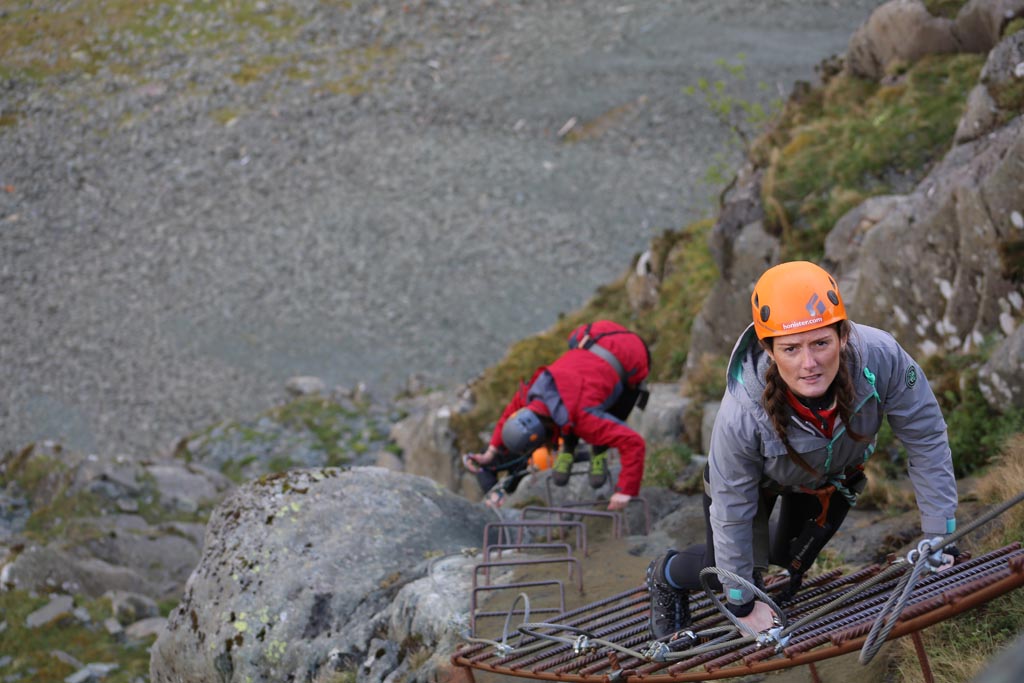
Many UK via ferratas are suitable for beginners. © Honister Via Ferrata
Where are the via ferrata sites in the UK?
ENGLAND
Honister Slate Mine – Cumbria
What could be better than a day spent climbing in one of the country’s most beautiful counties? Honister Slate Mine is situated near the town of Keswick in the north Lake District on the Honister Pass, a winding, undulating road that connects the Buttermere and Borrowdale valleys. It’s believed that slate might first have been extracted from Honister during Roman times, but the first real surviving evidence of slate mining at Honister is from around 1643, and mining ceased there in 1986.
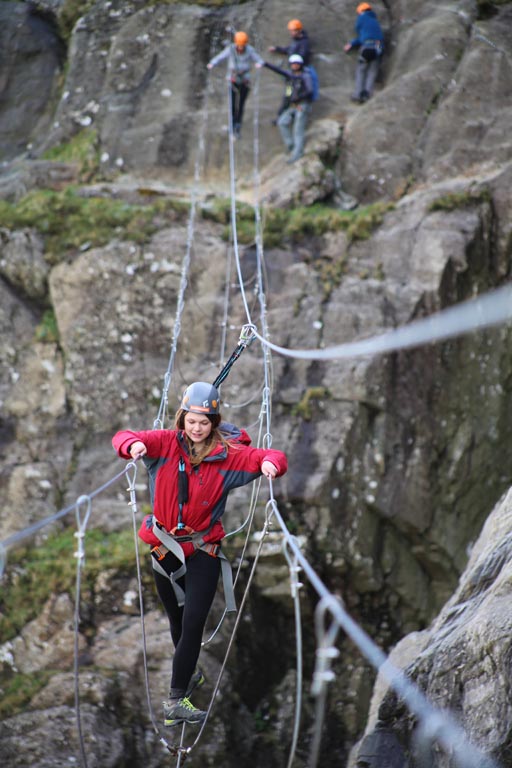
Honister’s via ferratas use the original miners’ track up the steep outer incline of Fleetwith Pike. © Honister Via Ferrata
Nowadays, Honister is home to the UK’s original via ferrata, the Classic, and also the Xtreme which opened in 2012. For both, participants need to be over 10 years old and above 1.3m tall, and whilst both routes take around 3 hours, they each have different things to offer.
Honister’s Classic route is suitable for most ages and abilities. Using the original miners’ track up the steep outer incline of Fleetwith Pike, following a continuous cable through the moody, grey landscape of the Honister Pass, taking in breathtaking views of the Lakeland landscape. Whilst neither require previous climbing experience, the Classic is a friendlier option than the Xtreme if you’re feeling a little jittery, and an excellent introductory path to the dizzy heights of via ferrata.
As the name perhaps suggests, the Xtreme requires a good level of fitness and includes more challenging terrain and exposure. Those with a hankering for the additional challenge of the Xtreme will find themselves tackling vertical ladder climbs, overhanging descent, a Burma bridge and sky ladder to finish – not for the faint hearted! Once completed there is a short scramble to the summit where you can catch your breath, overlooking Buttermere, Crummock and Loweswater, as well as Alfred Wainwright’s favourite fell, Haystacks.
Recently, Honister has updated their activity offering to include the longest highwire bridge in Europe and ‘the jump’, which can be combined with a via ferrata experience in a 3-4 hour Adrenaline Pass.
Via Ferrata Cornwall – Penryn
Historic granite quarries form the backdrop for this iron path, situated a stone’s throw away from the picturesque seaside towns of Penryn and Falmouth on Cornwall’s south coast, an area perhaps better known for its maritime heritage, cream teas and culture, seafood and surfing.
Via Ferrata Cornwall‘s 60 acre site has two different routes to tackle; the family-friendly Adventure Zone, which is suitable for ages 8 and up and covers the very basics of via ferrata from the ground up followed by a high-wire bridge crossing on a 70m long single strand of wire (1-1.5 hours), and the Full Classic, which is for ages 10 and up. The latter completes the initial Adventure Zone introduction and training circuit, then onwards to test your limits negotiating sheer rock faces and cliffs at heights of 20 metres, plus the grand finale of a zip wire above the water-filled quarry (2-3 hours).
The minimum height for participants is 1.2m and under 18s wishing to take on the Full Classic must be accompanied by an adult undertaking the route with them. If you’ve not quite got your adrenaline fix after that, the centre also offers a myriad of other activities too, including climbing, SUP and archery.
Via Ferrata Cornwall is a Community Interest Company and was established by charity BF Adventure, all profits from the via ferrata go towards supporting Cornwall’s vulnerable children and young people facing life’s toughest challenges, offering support and helping them to build crucial life skills through trauma-informed youth work in the outdoors.
How Stean Gorge – Yorkshire
Feeling inspired to take your via ferrata adventures further afield? Set in the heart of the Yorkshire Dales, How Stean Gorge offers a day-long, in-depth via ferrata course with a professional instructor that aims to assist adult participants to become self-sufficient on via ferrata in preparation for unguided excursions on larger via ferratas such as those in the Dolomites. The course covers crucial elements of safety, technique and knowledge including grading, route planning and etiquette and group ratios are a maximum of 6:1 learners to guide, to really help you consolidate your skills.
Of course, if you’re just after a day of adventure in God’s Own Country, there’s plenty on offer at How Stean. Thrill-seekers over 7 years old and 1.4m tall can take on the via ferrata and high wires course in shorter sessions that run at 9.30am and 1.30pm daily. Participants will find themselves crossing a beam that spans a spectacular limestone ravine with a gushing waterfall beneath, traversing the gorge walls using a network of metal cables including a Burma bridge and Tyrolean traverse – you then abseil from the bridge to begin the course again in reverse!
How Stean is an excellent location for a number of activities such as gorge walking, caving, rock climbing, canyoning and abseiling, and the centre caters to group bookings including school parties, with a focus on team-building and personal development through confidence, communication and reflection. How Stean is geographically unique, as a Site of Special Scientific Interest in Nidderdale, and an Area of Outstanding Natural Beauty.
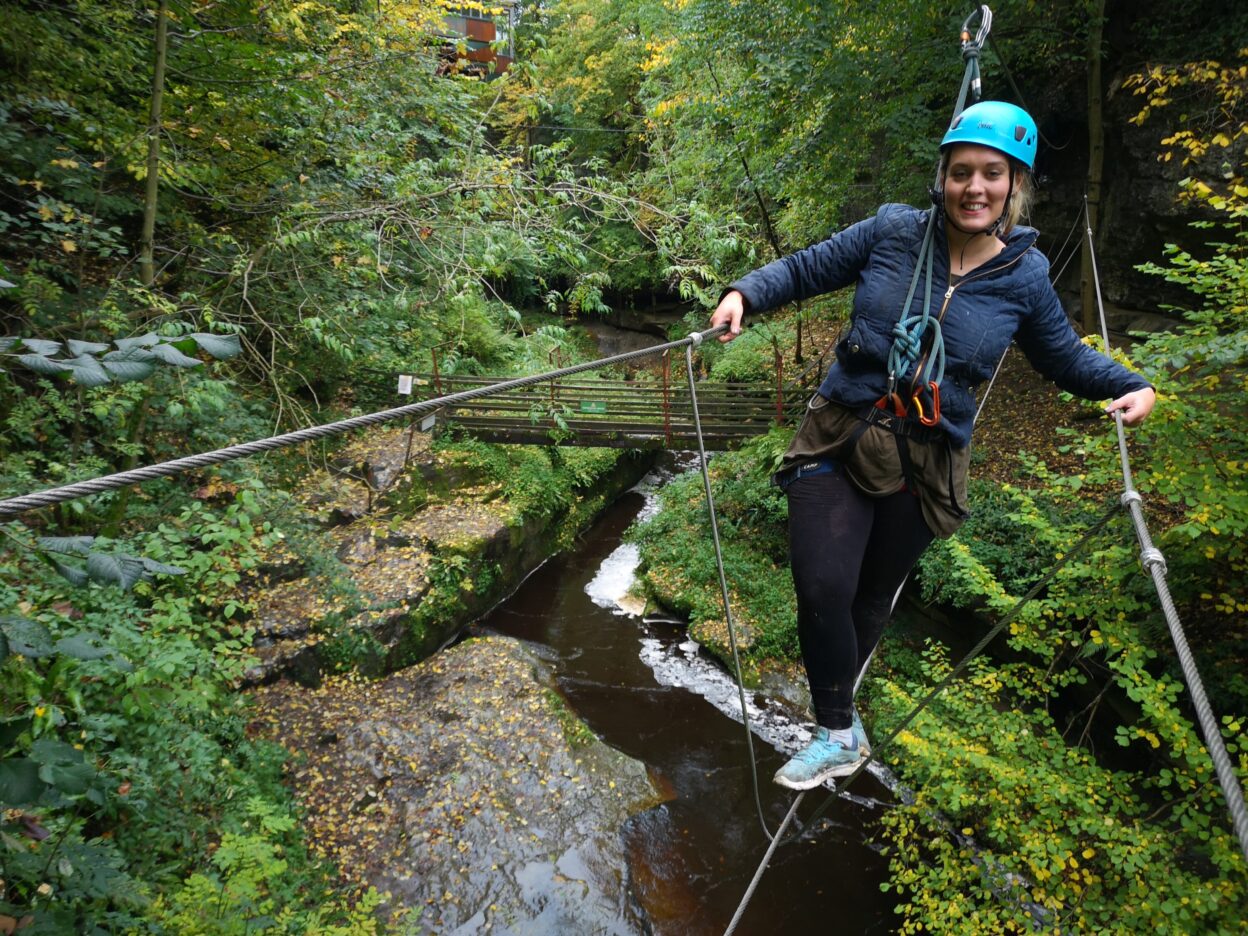
© How Stean Gorge
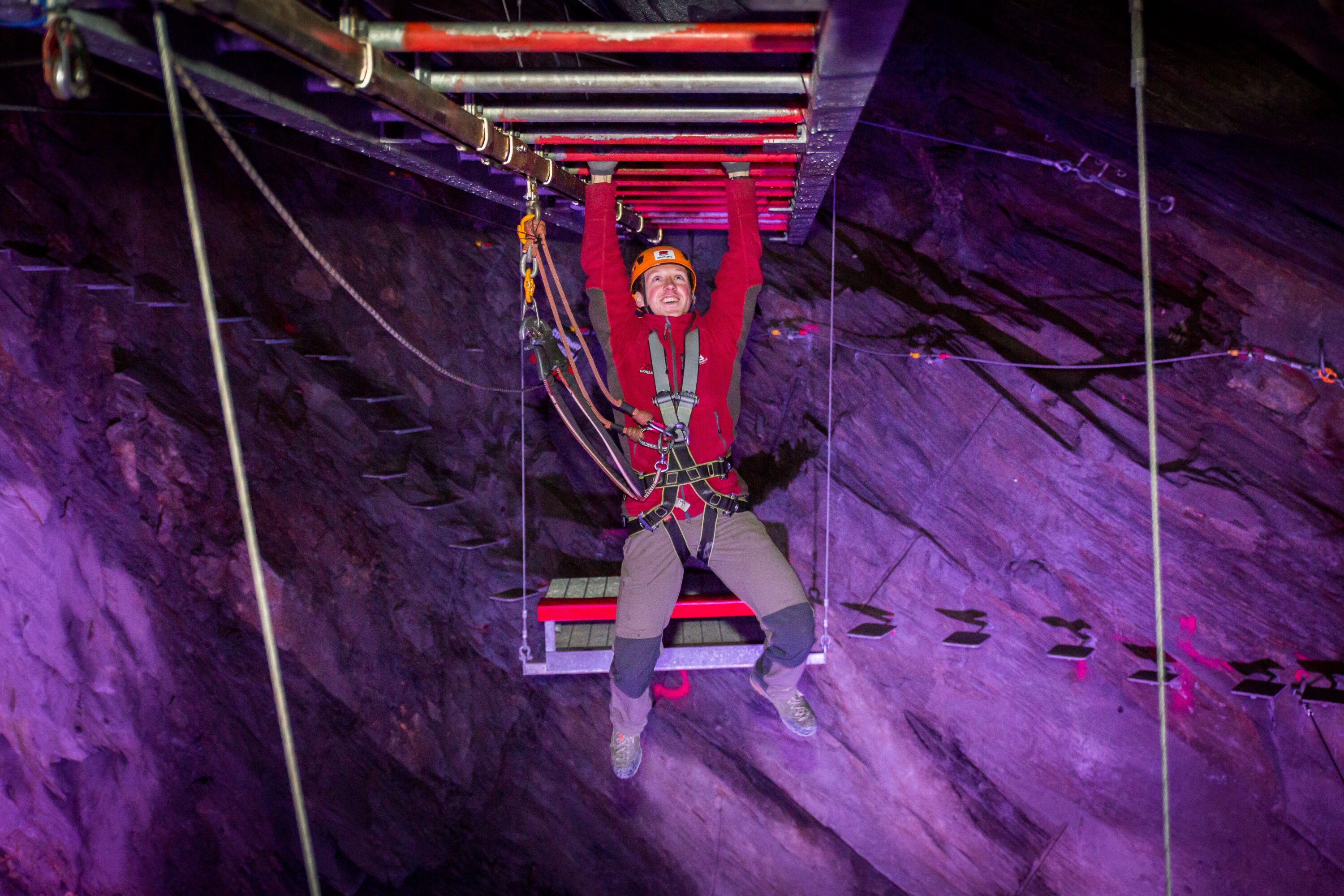
WALES
Zip World Caverns – Blaenau Ffestiniog
Set in the heart of Snowdonia National Park, North Wales, Zip World Caverns has a via ferrata with a bit of a twist!
The unique, three hour course takes you through historic underground slate mines, combining elements of via ferrata with a staggering 13 zip lines as well as rope bridges, tightropes, and colourfully illuminated caves and tunnels. The course is open to anyone over 1.2m tall, but under 18s must be accompanied by an adult. It’s an all-weather activity (because it’s underground) and ideal for when the worst of the Welsh weather hits, although it can be a bit chilly down there, so be prepared with warm clothes.
The unique, three-hour course takes you through historic underground slate mines, combining elements of via ferrata with a staggering 13 zip lines
If you want to know a bit more about the history of the caverns you’ll be swinging and leaping around in, you can take an educational tour of the Llechwedd mine in which the via ferrata and high wires course is located.
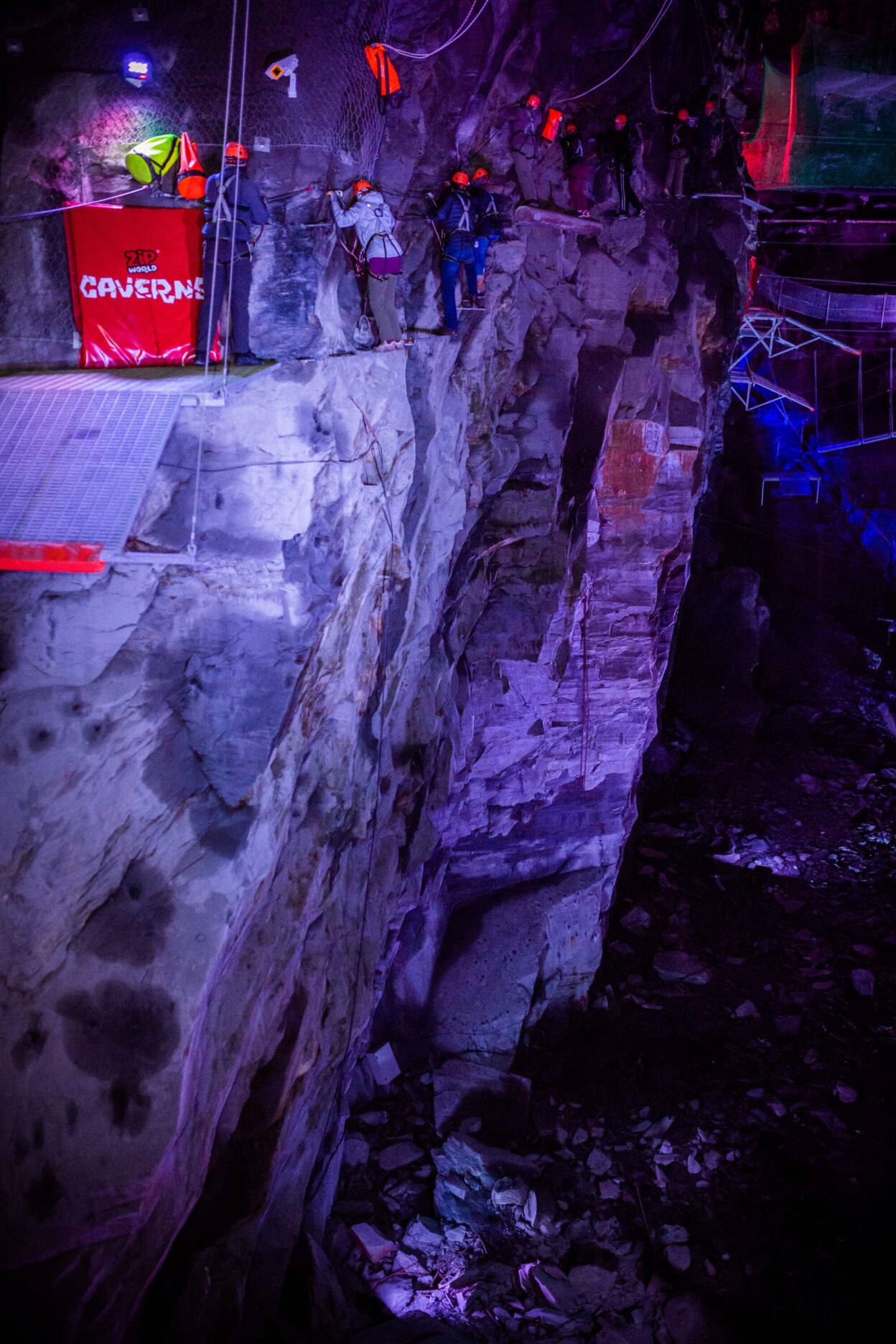
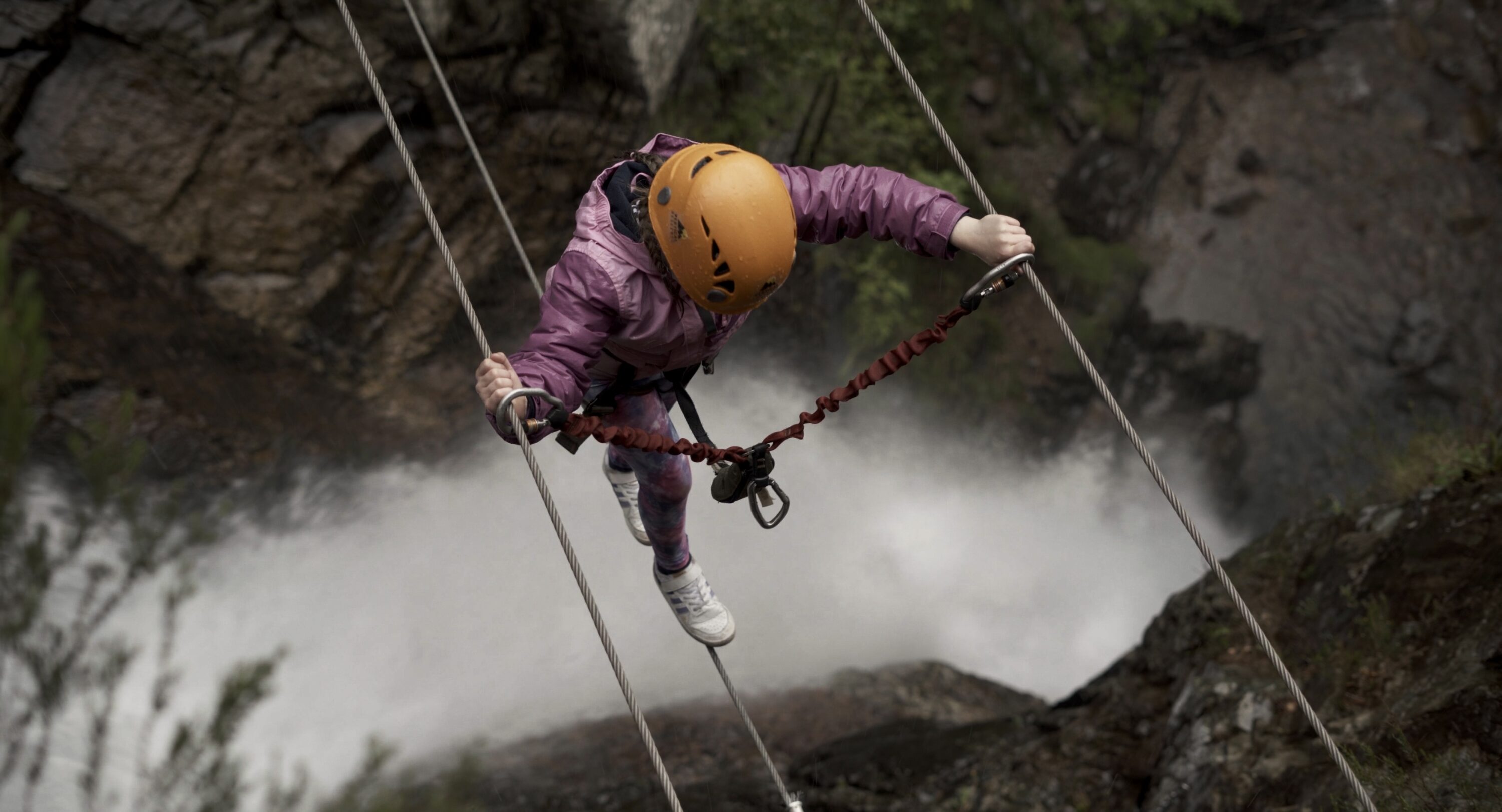
© Vertical Descents
SCOTLAND
The Grey Mare’s Tail – Kinlochleven
The Scottish Highlands are well-known amongst those with a taste for the great outdoors – with wild and imposing mountains to climb, expansive lochs for those with a passion for wild swimming, paddle sports, hiking and biking a’plenty, it’s a year-round adventurer’s playground.
A few hours drive north from Honister, Scotland’s one and only Via Ferrata offering features a 450m long succession of rungs and cables that traverse a vertical rock face, up and then over the country’s third biggest waterfall, The Grey Mare’s Tail. Guided excursion from Vertical Descents outdoor centre, which is situated in Kinlochleven near Fort William, will take you on a 2-3 hour long, vertical adventure through this spectacular corner of the Scottish Highlands. Vertical Descents also offer a number of other land and water activities for thrill seekers including canyoning, coasteering and gorge walking from their centres in Glencoe, Oban and Fort William.
The route is open to anyone over 8 years old and over the height of 1.2m, and whilst no previous climbing experience is needed, it is recommended that you are comfortable with heights and exposure or ready to get over your fear. The course is designed for a variety of abilities, so it’s ideal for beginners with a good level of fitness. You can take on The Grey Mare’s Tail all year round (weather permitting), though of course, you’d be remiss to forget your waterproofs!
Can’t wait to for your next adventure on the iron path? Get inspired by this article by Kirsty McDonald about her first foray into via ferrata in Andorra.
Don’t miss a single adventure
Sign up to our free newsletter and get a weekly BASE hit to your inbox
Other posts by this author

Story • Hannah Mitchell • Jul 28, 2023
Reframe, Engage, Create Change
How Arc'teryx's ReBIRD program is engaging consumers with the concept of circularity in the outdoor clothing industry

Story • Hannah Mitchell • Jun 27, 2023
The UK’s Best ‘Almost Wild Camping’ Spots For 2023
Back-to-basics camping and wild vibes... but with a few added comforts

Interview • Hannah Mitchell • Jun 13, 2023
Chasing The 14: The Kristin Harila Interview
In conversation with record-breaking Norwegian mountaineer and Osprey ambassador, Kristin Harila

You might also like
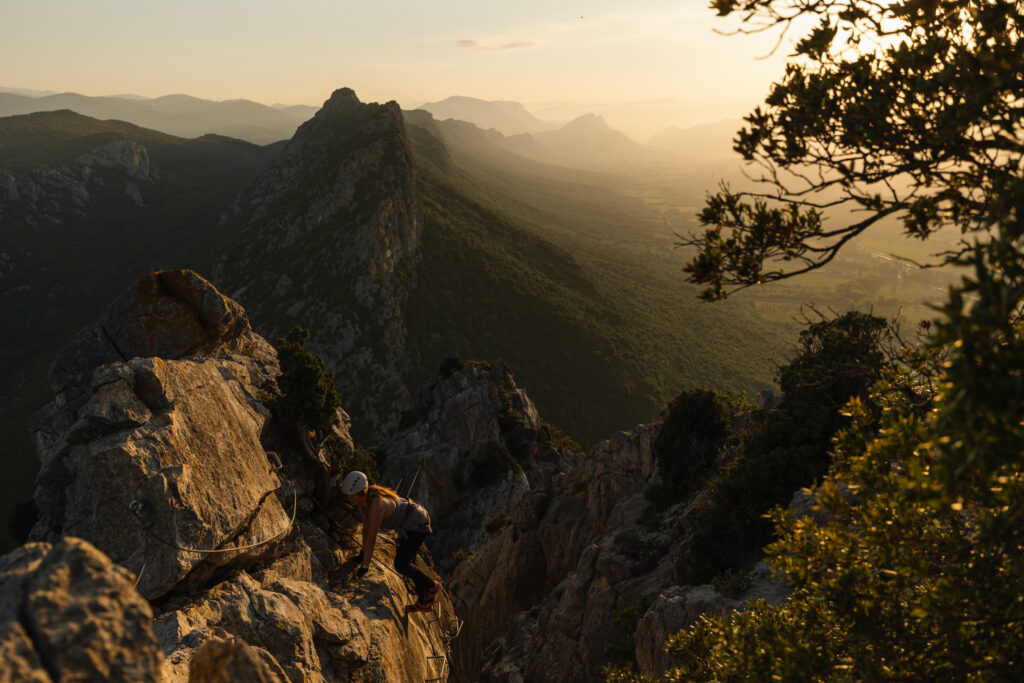
Story • Kirsty McDonald • Sep 15, 2022
An Introduction to Via Ferrata
Learning the ropes along Andorra's iron paths

